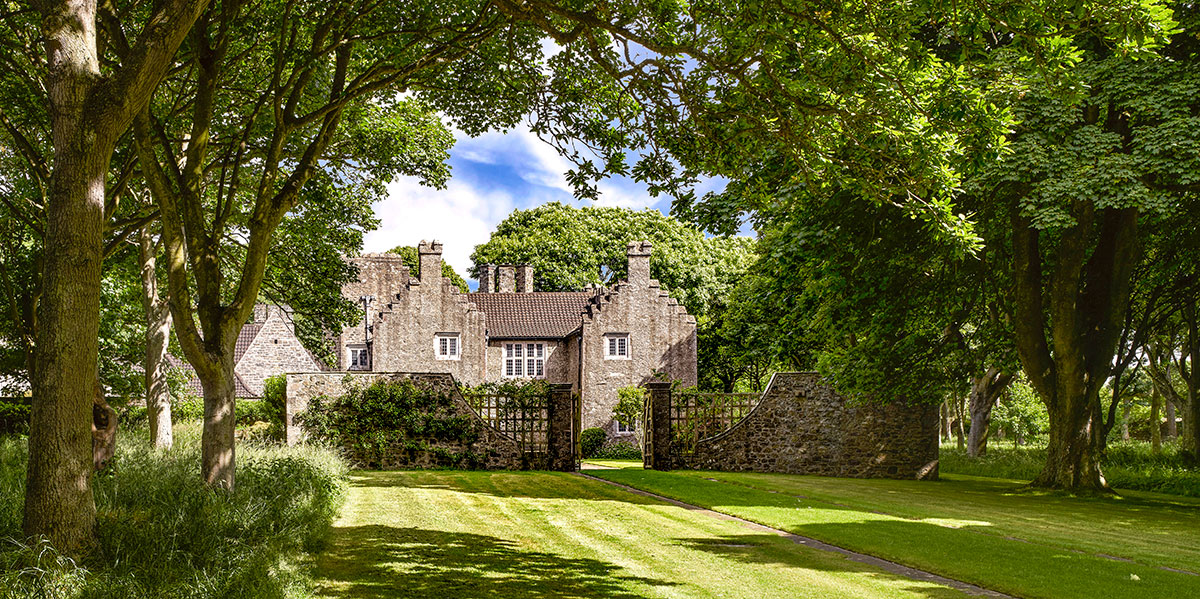Lambay Castle
When Cecil Baring and his new wife decided to turn their backs upon society they chose Lambay, a small island in the Irish Sea less than three miles off the coast of north County Dublin. The couple engaged the fashionable architect Sir Edwin Lutyens, who transformed a small ruined fort “into a romantic castle” and placed it in the centre of a majestic circular enclosure beneath a canopy of sycamore trees. The result is one of Ireland’s few important Edwardian country houses and the only remaining Irish house entirely designed by Lutyens.
Lambay has been inhabited since ancient times. After a long association with Dublin’s Christchurch Cathedral during the medieval era the island changed hands with increasing frequency after the Reformation. The most important owner during this period was the remarkable James Ussher (1581-1656), theologian, Protestant Archbishop of Armagh and the man responsible for returning the Book of Kells to Ireland.
Cecil Baring (1864-1934), scion of the London banking dynasty and subsequently the 3rd Lord Revelstoke, purchased Lambay in 1904. While working in America he met and fell in love with Maude, daughter of the tobacco millionaire Pierre Lorillard. She divorced her husband, the couple married and together they chose Lambay as their refuge from the world.
Today the three-bay centre of the north-west front, which faces a bastion gateway in the Rampart Wall, is flanked by two full-height projecting bays, each with crow-stepped gables and tall chimneys. Lutyens attached a wing to provide guest accommodation at the northeastern corner and regarded the "link between the two buildings as one of his most brilliant architectural coups" since the castle, which appears single storied on this front, continues to dominate the two-storey wing. The castle and the farm buildings, and the walls of the much enlarged gardens were built in grey-green Lambay stone, with grey pantile roofs, and form a sequence of courts, walled gardens and enclosed yards that give the impression of a small hamlet nestling for protection beneath the castle walls.
Lambay is exposed to the elements and the castle is “constructed with small doors and small casements so that the inhabitants seem, on rough days, to be sheltering like monks.” The interior has vaulted ceilings, stone fireplaces and a curved stone staircase, while much of the furniture chosen by Lutyens is still arranged just as he intended.
He also adapted and enlarged a number of other early structures and integrated them into an ingenious coordinated layout for the whole island, combining the farm, gardens and plantations as a single composition, in collaboration with the horticulturalist and garden designer Gertrude Jekyll.
The walled kitchen garden pierces the Rampart Wall to the South and there is the mausoleum of the Revelstokes, designed by Lutyens in 1930, on the opposite side of the enclosure. He also designed the White House overlooking the harbour on the western shores of the island, as a holiday home for the couple’s two daughters and their families. Alongside is a row of old Coastguard cottages and an open-air Real Tennis court, one of only two still in existence in Ireland.
In the mid 1900s Lambay was home to more than 80 islanders but today it is maintained by a handful of hardy individuals. Cecil and Maud’s numerous descendants still own the island where their great-grandson Alex, the 7th Lord Revelstoke, is the resident guardian and curator. Thus Lambay is the only one of Lutyens’ and Jekyll’s joint collaborations that still belongs to the family that commissioned their work.
Lambay Island is a haven for wildlife and a National Bird Sanctuary. Resident fauna includes a herd of fallow deer, a thriving colony of Atlantic grey seals, which pup on Lambay’s sheltered beaches, and, most unusually, a troop of wild wallabies. The diverse bird life is of far greater significance, for this is an important seabird colony and their cries can be heard throughout the island. Nesting birds include fulmars, guillemots, herring gulls, kittiwakes, Manx shearwaters and puffins, while greylag geese are common winter visitors.
Address & Contact
Lambay Castle, Lambay Island, Rush, DublinAvailable as a Film Location
Houses and Garden
Groups by Arrangement
Culture and Education
Educational Visits
Accommodation and Short Breaks
Holiday Cottages
Events
Meetings or receptions
Opening Details
Access to Lambay Island is by prearranged ferry from Rush.
All tours are based on a group of 12 (the complement of one boat).
Lambay Castle and the White House are also available for rent.
And the whole island can be rented as a single unit.
All booking arrangements must be made well in advance.


